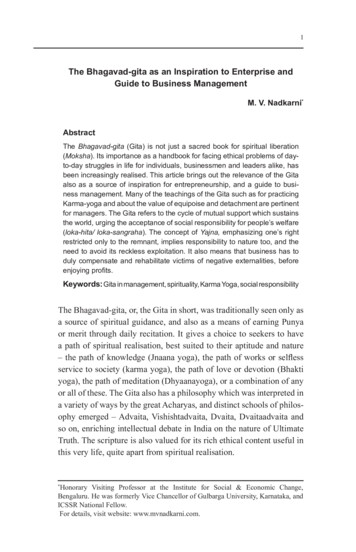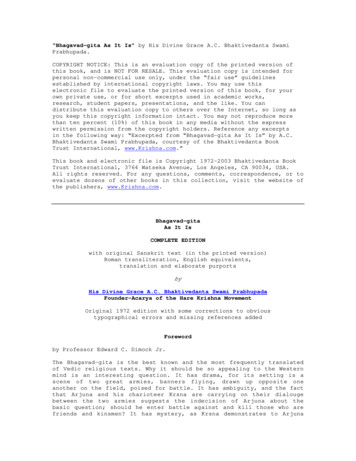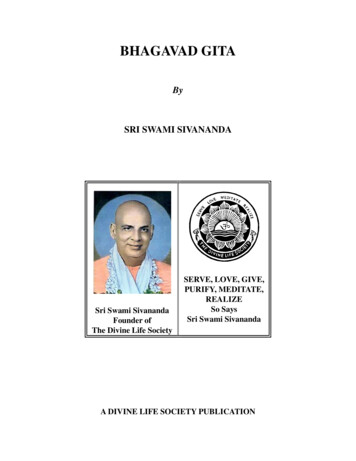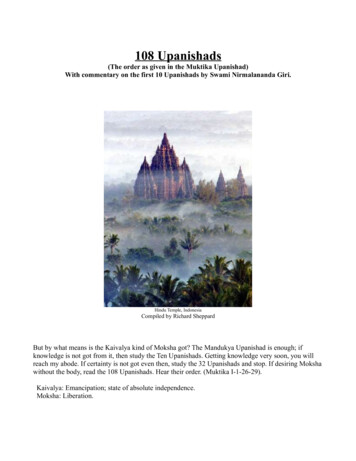
Transcription
1The Bhagavad-gita as an Inspiration to Enterprise andGuide to Business ManagementM. V. Nadkarni*AbstractThe Bhagavad-gita (Gita) is not just a sacred book for spiritual liberation(Moksha). Its importance as a handbook for facing ethical problems of dayto-day struggles in life for individuals, businessmen and leaders alike, hasbeen increasingly realised. This article brings out the relevance of the Gitaalso as a source of inspiration for entrepreneurship, and a guide to business management. Many of the teachings of the Gita such as for practicingKarma-yoga and about the value of equipoise and detachment are pertinentfor managers. The Gita refers to the cycle of mutual support which sustainsthe world, urging the acceptance of social responsibility for people’s welfare(loka-hita/ loka-sangraha). The concept of Yajna, emphasizing one’s rightrestricted only to the remnant, implies responsibility to nature too, and theneed to avoid its reckless exploitation. It also means that business has toduly compensate and rehabilitate victims of negative externalities, beforeenjoying profits.Keywords: Gita in management, spirituality, Karma Yoga, social responsibilityThe Bhagavad-gita, or, the Gita in short, was traditionally seen only asa source of spiritual guidance, and also as a means of earning Punyaor merit through daily recitation. It gives a choice to seekers to havea path of spiritual realisation, best suited to their aptitude and nature– the path of knowledge (Jnaana yoga), the path of works or selflessservice to society (karma yoga), the path of love or devotion (Bhaktiyoga), the path of meditation (Dhyaanayoga), or a combination of anyor all of these. The Gita also has a philosophy which was interpreted ina variety of ways by the great Acharyas, and distinct schools of philosophy emerged – Advaita, Vishishtadvaita, Dvaita, Dvaitaadvaita andso on, enriching intellectual debate in India on the nature of UltimateTruth. The scripture is also valued for its rich ethical content useful inthis very life, quite apart from spiritual realisation.Honorary Visiting Professor at the Institute for Social & Economic Change,Bengaluru. He was formerly Vice Chancellor of Gulbarga University, Karnataka, andICSSR National Fellow.For details, visit website: www.mvnadkarni.com.*
2The Bhagavad-gita as an Inspiration to Enterprise and Guide to Business ManagementThe original Gita being in Sanskrit, which is not the spoken languageof the masses in India, has never hindered its popularity, particularlyafter Sant Jnaneshwar translated it in Marathi verse in the 13th century,followed by translations in almost all the Indian languages well beforethe middle of the last century. When the first English translation of theGita by Charles Wilkins appeared in 1785 in London, it was recognisedas the sacred scripture of Hindus, like the Bible to Christians. A hundredyears later, after the publication of Sir Edwin Arnold’s translation ofthe Gita in verse in 1885, The Song Celestial, it began to be treatedas a storehouse of universal values with much general interest, notconfined to the Hindus alone. The Gita became global by the end of the19th century. Many Western thinkers saw it as a source of deliverancefrom excessive materialism. By now, the Gita has been translated intoalmost all the languages (if not dialects) of the world, and in Englishalone there are over two hundred translations.The Gita, however, is only one of the many books in India consideredas sacred. Its teachings are based on the Vedas and Upanishads whichpreceded it. The Gita has the advantage of being concise, containing only700 verses, and easier to understand than other texts like the Brahmasutras. It is originally a part of the Bhishma Parva of the Mahabharata,but can stand alone as an independent text. The text is in the form of a dialogue between Lord Krishna and Arjuna, which took place on the battlefield just before the battle was to begin. It was the sudden loss of will onthe part Arjuna to fight with his teachers, elders, and cousins, after botharmies came face to face in the battlefield that occasioned this famousdialogue. It was Lord Krishna’s task to inspire Arjuna back into action.The value of the Gita as a source of inspiration and guidance in mundane problems, both at the national and individual level, was realisedonly recently since the 18th century, compared to its long recognitionas a sacred book. This use had to do with the Gita’s practical approachto ethics. Practical approach does not mean that for the sake of practical convenience, ethical principles could be compromised. That wouldamount to hypocrisy, and the Gita abhors hypocrisy as mithyaachaara(chapter III.6) or dambha (ch. XVI.10). Practical approach to ethicsmeans having the potential to guide through ethical problems onefaces in day to day life. These problems arise at various levels – in theVol 9 Issue 1 Year 2015 Nitte Management Review
M. V. Nadkarni3private lives of individuals, in community or national problems, and ofcourse in business enterprises. The very background of the Gita is setin a battle field. Gandhi and many others have regarded the battlefieldbackground of the Gita as a metaphor for the struggle of life. Struggleis inevitable in life. The triumph of the good over the evil, or of justiceover injustice, does not take place automatically, but only through arelentless struggle. During the days of India’s freedom struggle, theGita was taken as a direct source of inspiration for the national movement by such luminaries as Bankim Chandra, Bal Gangadhar Tilak,and Sri Aurobindo. Raja Rammohan Roy used the Gita as a source ofsupport for reforming the Hindu society and for eradicating such socialevils as child marriage and the Sati system. He used the Gita even tooppose idolatry and superstitiona. Mahatma Gandhi treated the Gita ashis mother, as a source of solace, and guide in all practical problems hefaced in the freedom struggle he led and in social reforms he launched.He wrote in 1925:“I find a solace in the Bhagavadgita that I miss even in the Sermonon the Mount. When disappointment stares me in the face and allalone I see not a ray of light, I go back to the Bhagavadgita. I finda verse here and a verse there and I immediately begin to smile inthe midst of overwhelming tragedies – and my life has been fullof external tragedies – and if they have left no visible, no crediblescar on me, I owe it to the teachings of the Bhagavadgita.”--Mahatma Gandhi in Young India 1925 (pp. 1078-79); CWMGVol. 32, p. 195.It is no wonder that the Gita has now come to be seen as a sourceof inspiration for business enterprise and guide to management. In asense, the modern business environment under competitive capitalismalso looks like a ruthless battlefield. Starting a new business needscourage, an enterprising spirit, and pride in doing it. The timid cannotstart business enterprises, nor can satisfactorily run them as they maybuckle down under pressure of competition. What verse can be moreinspiring and invigorating than the third one in chapter 2? It says:Klaibyam maasma gamah Partha naitat tvaiyyupapadyate /Kshudram hridaya daurbalyam tyaktvotthishta Parantapa //For details, see Nadkarni (2013: 257), and Agarwal (1993: 19: 48).a
4The Bhagavad-gita as an Inspiration to Enterprise and Guide to Business ManagementIt means: ‘Yield not to unmanliness, O Son of Pritha! Ill doth it becomethee. Cast off this mean faint-heartedness and arise, O Scorcher ofthine enemies!’8.Swami Vivekananda considered this verse as containing the wholemessage of the Gita (CWSV Vol. IV, 1998: 110). He thought it to beparticularly relevant to the then mass of Indians immersed in ignorance and superstition who needed to struggle for a respectable placein the comity of nations. They had to fight numerous social evils likeuntouchability and mass illiteracy. But the verse can be consideredto be equally relevant to talented young men inspiring them to starttheir own enterprises and create new employment instead of tamelybeing content with being employed by others. An unenterprising orinert nature (apravritti) is condemned by the Gita as taamasika (ofthe quality of darkness, dullness, or passivity)2 (chapter XIV, verse 13;XIV. 13 henceforth).However, the enterprising will always find ups and downs, which theyhave to face with equanimity and patience. ‘Have patience’ (titikshasva),says the Gita emphatically (II. 14). An important message of the Gita is:Treat joy and sorrow, profit and loss, success and failure with equipoise,and be ready to struggle (sukha-duhkkhe same kritvaa laabhaalaabhaujayaajayau/ tato yuddhaaya yujyasya //) (II. 38). How is it possible?The Gita says, through detachment (sangam tyaktvaa). A certain amountof detachment even while actively engaged in work, helps one to gainan evenness of mind (samatvam) against ups and downs, success andfailure (siddhyahsiddhyoh) (II.48). Apart from saving from stress anddepression, detachment equips one to deal with all vicissitudes calmlyand efficiently. Detachment does not mean non-seriousness with workor lack of commitment. The Gita is very emphatic about working withdexterity (yogah karmasu kaushalam) (II. 50). It considers workingwith fortitude (Dhriti) and enthusiasm (utsaaha) as saatvika, the mostdesired of the three gunasb or mental qualities (XVIII.26). There is noThe concept of Gunas is taken by the Gita from the Sankhya philosophy. The threegunas are Saatvika, Raajasika, and Taamasika, which, loosely translated, respectivelymean truthful, emotional, and dull. The concepts were originally applied to naturalmental qualities, but can be used in other cases also. For a tabular representationof how the concepts can be applied to various things like individual’s nature, work,devotion etc. see Nadkarni (2013: 59-60). There is a detailed discussion of the gunasin the Gita in chapters 17 and 18.b
M. V. Nadkarni5question of the Gita accepting indifference to quality of work as detachment. But the detachment as taught by the Gita is a key both to successand survival. An entrepreneur, whether an industrialist or farmer, hasto accept risks and uncertainties as unavoidable facts of life, and beready to face them with boldness and confidence. The tragic suicides ofnumerous farmers or even of small businessmen are a consequence ofnot imbibing this teaching of the Gita. Even if a business goes into liquidation, a business person should not loose cool and equipoise, and beready to reincarnate himself or herself within this God-given life. Thereis a famous verse in the Gita (II. 22) which has served as a source ofsolace in the context of passing away of a dear one. It says: ‘Even as aman casts off worn-out clothes, and puts on new ones, so the embodiedcasts off worn-out bodies, and enters into others which are new’8. Thisverse could as well be applied to situations of failure or liquidation of abusiness enterprise. An entrepreneur should not lose his or her cool insuch situations, but be ready to learn from experience and start a newenterprise. Professor B Mahadevan interprets this verse as teaching theneed to discard obsolete ideas and experiment with new ones in business; it is a mantra for innovationc.Hindu scriptures have accepted the goal of earning wealth as a validPurushaartha (human goal). Earning wealth per se is not regardedas a sin, but is encouraged on the contrary. It is considered as theduty of a householder to earn, take care of family, be hospitable, andhelp others. The principles of morality are applicable to all includinghouseholders. They have no concessions or exemptions from them justbecause they need to earn, though sanyasis are subject to even morerigorous moral and spiritual discipline. Similarly, business enterprisesenjoy no exemptions from the principles of morality, just because theyare in business. They have in fact special responsibilities because theyare in a position to control the lives of others. The Rigveda gave ageneral advice which is relevant even today, both for individuals andbusiness enterprises. Though this essay is on the Gita, the advice fromthe Rigveda is pertinent in the context of what the Gita also has to sayfurther on the issue. The Rigveda says:See B Mahadevan, ‘Bhagavad Gita: Ideas for Modern Management’, talk deliveredin a Seminar on ‘Towards a new paradigm of business management: Alternativeperspectives from ancient Indian wisdom’, at IIM, Bangalore, December 12, , p. 2.c
6The Bhagavad-gita as an Inspiration to Enterprise and Guide to Business ManagementParichin marto dravinam mamanyaad ritasya pathaa namasaavivaaset /Uta svena kratunaa samvadeta shreyaamsam daksham manasaajagribhyaat //--- Rigveda X. 31.2(Let a man/woman ponder well on wealth, earn it through the path ofmoral law and with humility, consulting one’s own conscience, andthen heartily gain upright prosperity. Tr. by the author.)Wealth does not come on its own. One has to consciously ponder(parichin) over how it has to be earned through the path of moral lawor truth (ritasya pathaa), and not by dishonest means. It has to beearned with humility (namasaa), since success depends on the grace ofGod and one owes it to the society at large for making it possible. Ethical dilemmas are bound to arise, which have to be resolved throughconsulting one’s conscience (kratunaa samvadeta) or Inner Voice asGandhi called it. Once these qualifications or conditions are respectedand followed, one can heartily (manasaa) earn wealth and gain welldeserved (daksham) prosperity (shreyaamsam)d.he Gita implicitly accepts this, but also adds that the wealth earnedmust also be shared and be used for the welfare of humanity(lokahita). Earning wealth has to be done in the spirit of a Yajna,an offering, and one should enjoy its fruit only after meeting thedues of all; that is, one has a right to eat only the remnants of Yajna.The Gita, further explains this by say
dexterity (yogah karmasu kaushalam) (II. 50). It considers working with fortitude (Dhriti) and enthusiasm (utsaaha) as saatvika, the most desired of the three gunasb or mental qualities (XVIII.26). There is no . M. V. Nadkarni 5 question of the Gita accepting indifference to quality of work as detach - ment. But the detachment as taught by the Gita is a key both to success and survival. An .











